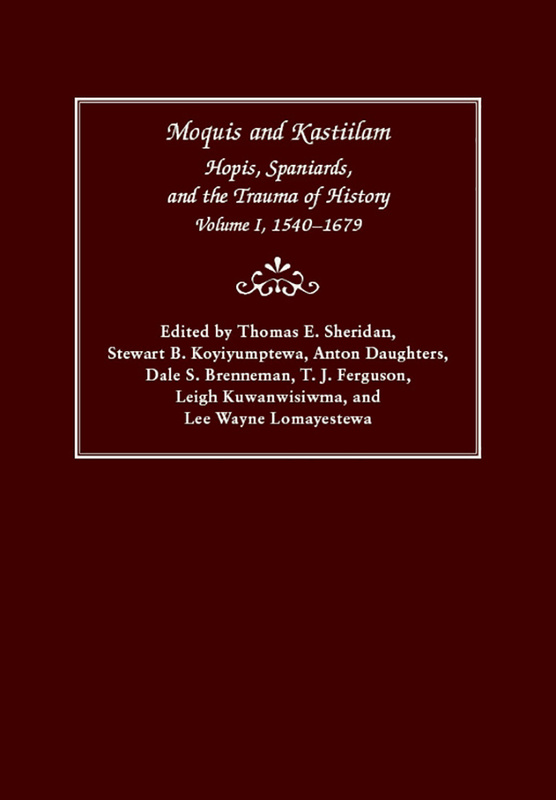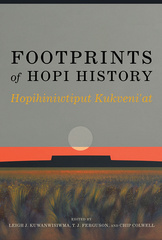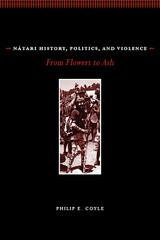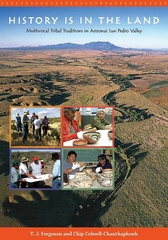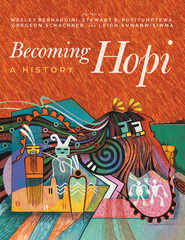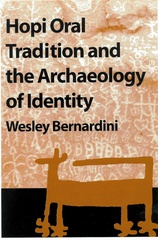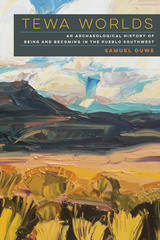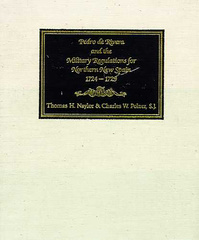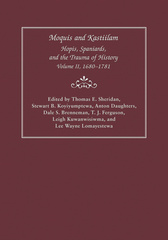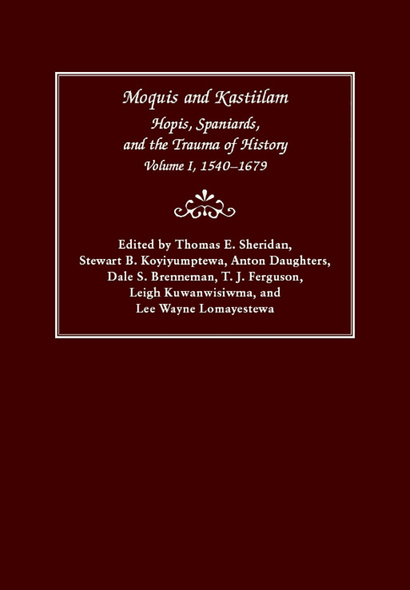
360 pages, 7 x 10
6 halftones, 4 maps
Hardcover
Release Date:12 Nov 2015
ISBN:9780816531844
Moquis and Kastiilam
Hopis, Spaniards, and the Trauma of History, Volume I, 1540–1679
Edited by Thomas E. Sheridan, Stewart B. Koyiyumptewa, Anton Daughters, Dale S. Brenneman, T. J. Ferguson, Leigh J. Kuwanwisiwma, and Leigh Wayne Lomayestewa
The University of Arizona Press
The first of a two-volume series, Moquis and Kastiilam tells the story of the encounter between the Hopis, who the Spaniards called Moquis, and the Spaniards, who the Hopis called Kastiilam, from the first encounter in 1540 until the eve of the Pueblo Revolt of 1680. By comparing and contrasting Spanish documents with Hopi oral traditions, the editors portray a balanced presentation of their shared past. Translations of sixteenth-, seventeenth-, and eighteenth-century documents written by Spanish explorers, colonial officials, and Franciscan missionaries tell the perspectives of the European visitors, and oral traditions recounted by Hopi elders reveal the Indigenous experience.
The editors argue that the Spanish record is incomplete, and only the Hopi perspective can balance the story. The Spanish documentary record (and by extension the documentary record of any European or Euro-American colonial power) is biased and distorted, according to the editors, who assert there are enormous silences about Hopi responses to Spanish missionization and colonization. The only hope of correcting those weaknesses is to record and analyze Hopi oral traditions, which have been passed down from generation to generation, and give voice to Hopi values and Hopi social memories of what was a traumatic period in their past.
Spanish abuses during missionization—which the editors address specifically and directly as the sexual exploitation of Hopi women, suppression of Hopi ceremonies, and forced labor of Hopis—drove Hopis to the breaking point, inspiring a Hopi revitalization that led them to participate in the Pueblo Revolt. Those abuses, the revolt, and the resistance that followed remain as open wounds in Hopi society today.
The editors argue that the Spanish record is incomplete, and only the Hopi perspective can balance the story. The Spanish documentary record (and by extension the documentary record of any European or Euro-American colonial power) is biased and distorted, according to the editors, who assert there are enormous silences about Hopi responses to Spanish missionization and colonization. The only hope of correcting those weaknesses is to record and analyze Hopi oral traditions, which have been passed down from generation to generation, and give voice to Hopi values and Hopi social memories of what was a traumatic period in their past.
Spanish abuses during missionization—which the editors address specifically and directly as the sexual exploitation of Hopi women, suppression of Hopi ceremonies, and forced labor of Hopis—drove Hopis to the breaking point, inspiring a Hopi revitalization that led them to participate in the Pueblo Revolt. Those abuses, the revolt, and the resistance that followed remain as open wounds in Hopi society today.
The compiling of many early references to the Hopis in a single source, and the inclusion of a Hopi perspective, make this work valuable to area specialists, anthropologists, and, it is hoped, the Hopi people themselves.’—Journal of Arizona History
‘Thanks to an innovative collaboration between the Arizona State Museum’s Office of Ethnohistorical Research and the Hopi Tribe, Hopi voices are heard.’—New Mexico Historical Review
‘A groundbreaking edition intertwining Hopi oral traditions—mostly dismissed in the past—with the Spanish documentary record.’—SMRC Revista
‘An innovative and invaluable cultural transcript of the legendary Hopi people.’—Choice
‘Placing historical Spanish and contemporary Indigenous perspectives in dialogue is really innovative. There is a growing literature about the need to reconcile historical and academic texts with Indigenous perspectives, but there are few examples of actual reconciliation. This book will be a heavily cited contribution to that literature.’—Wesley Bernardini, author of Hopi History in Stone: The Tutuveni Petroglyph Site
‘A highly significant contribution to our understanding of Hopi history during the sixteenth and seventeenth centuries, because it helps to counter the phenomenon that historian Loma Ishii calls Hopi historicide: ‘the mass execution of Hopi intellect, agency, and epistemology.’’—Susan Deeds, author of Defiance and Deference in Mexico’s Colonial North: Indians under Spanish Rule in Nueva Vizcaya
Thomas E. Sheridan holds a joint appointment as research anthropologist at the University of Arizona’s Southwest Center and professor in the School of Anthropology. He received his PhD in anthropology from the University of Arizona in 1983.
Stewart B. Koyiyumptewa received his BA from the University of Arizona in 1999. He is currently the archivist for the Hopi Tribe’s Cultural Preservation Office.
Anton Daughters is an assistant professor of anthropology at Truman State University. He received his PhD from the University of Arizona in 2010 and was an Andrew W. Mellon Postdoctoral Fellow at Cornell College from 2010 to 2012.
Dale S. Brenneman is associate curator of documentary history and director of the Office of Ethnohistorical Research at the Arizona State Museum. She received her PhD in anthropology from the University of Arizona in 2004.
T. J. Ferguson received his PhD in anthropology from the University of New Mexico in 1993. Since 2002, he has served as a professor of anthropology at the University of Arizona, in addition to being the sole proprietor at Anthropological Research, LLC.
Leigh Kuwanwisiwma is the director of the Cultural Preservation Office of the Hopi Tribe. He is a member of the Hopi Tribe and of the Greasewood Clan. He has served on the Arizona Archaeology Commission, the Museum of Northern Arizona Board of Trustees, the Tribal Advisory Team of the Arizona State Museum, and the Museum of Indian Arts and Culture.
LeeWayne Lomayestewa, a member of the Hopi tribe and the Bear Clan, is a research assistant and the NAGPRA coordinator for the Hopi Cultural Preservation Office of the Hopi Tribe. He serves as the president of the Native Nations Southwest Advisory Panel at the Arizona State Museum and as a member of the Indian Advisory Panel at the Museum of Indian Arts and Culture in Santa Fe, New Mexico.
Stewart B. Koyiyumptewa received his BA from the University of Arizona in 1999. He is currently the archivist for the Hopi Tribe’s Cultural Preservation Office.
Anton Daughters is an assistant professor of anthropology at Truman State University. He received his PhD from the University of Arizona in 2010 and was an Andrew W. Mellon Postdoctoral Fellow at Cornell College from 2010 to 2012.
Dale S. Brenneman is associate curator of documentary history and director of the Office of Ethnohistorical Research at the Arizona State Museum. She received her PhD in anthropology from the University of Arizona in 2004.
T. J. Ferguson received his PhD in anthropology from the University of New Mexico in 1993. Since 2002, he has served as a professor of anthropology at the University of Arizona, in addition to being the sole proprietor at Anthropological Research, LLC.
Leigh Kuwanwisiwma is the director of the Cultural Preservation Office of the Hopi Tribe. He is a member of the Hopi Tribe and of the Greasewood Clan. He has served on the Arizona Archaeology Commission, the Museum of Northern Arizona Board of Trustees, the Tribal Advisory Team of the Arizona State Museum, and the Museum of Indian Arts and Culture.
LeeWayne Lomayestewa, a member of the Hopi tribe and the Bear Clan, is a research assistant and the NAGPRA coordinator for the Hopi Cultural Preservation Office of the Hopi Tribe. He serves as the president of the Native Nations Southwest Advisory Panel at the Arizona State Museum and as a member of the Indian Advisory Panel at the Museum of Indian Arts and Culture in Santa Fe, New Mexico.
Acknowledgments
Introduction: Oral Traditions, Collaborative Research, and Hopi History
III. The Pueblo Revolt
IV. The Reconquista of Nuevo México and the Destruction of Awat’ovi
V. Tewa-Tano Settlers on First Mesa
VI. Rebuffing the Spaniards
VII. Jesuits versus Franciscans and the Hopi Missions
VIII. The Resettlement of Pueblo Refugees in the 1740s
IX. Trails to California
Appendix 1. Hopi and Tewa Consultants
Appendix 2. University of Arizona Staff and Graduate Student Researchers
Notes
Glossary
References
Index

